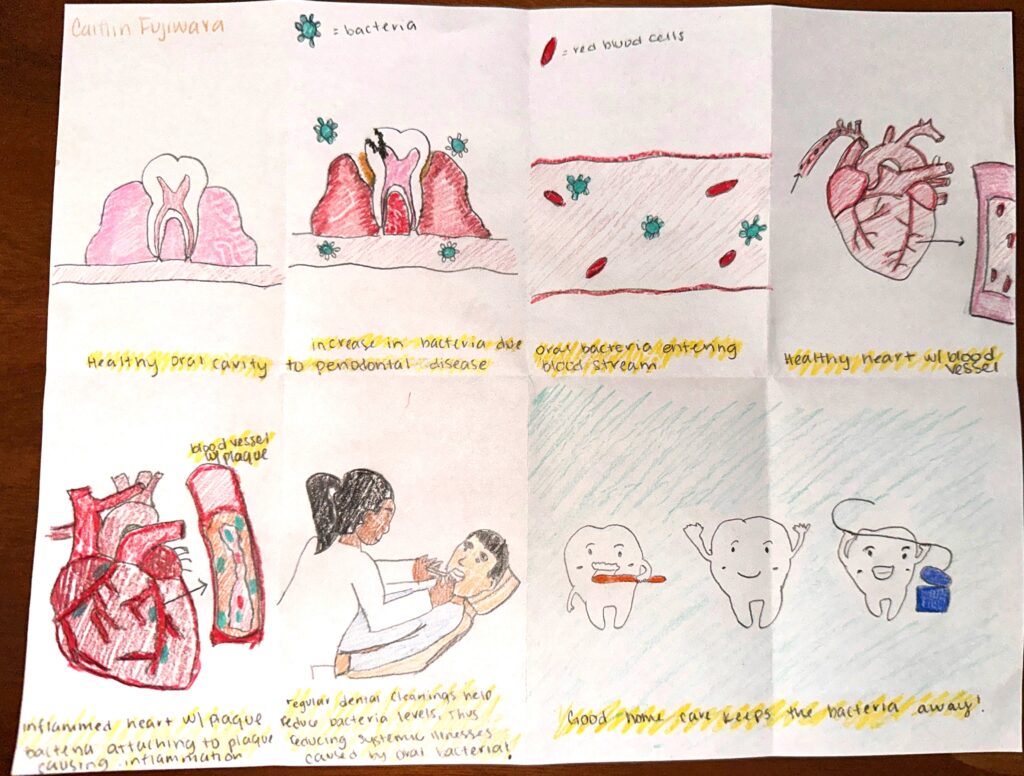
Oral Health and Cardiovascular Disease
For decades, medical health and dental health have been separated. This has led most individuals to disconnect their oral health from the rest of the body. But this is simply not the case. Research has been linking oral health and bacteria to systemic conditions throughout the body. One of these conditions is cardiovascular disease. Oral bacteria have been found in hard plaques in the heart. The essay aims to show the researched links that poor oral health is associated with cardiovascular disease.
As to how oral bacteria can reach the cardiovascular system, the theory can be easily explained. In the mouth, there are blood vessels in the gum tissues. If an individual has poor oral health (periodontal disease), there will be inflammation and damage to these blood vessels. This damage allows bacteria to enter into the blood vessels, thus into the blood stream. Within the tooth, the nerve is connected to blood supply as well. If an individual has a cavity that has reached the nerve or an abscessed tooth, the bacteria can easily enter the blood stream as well.
Evidence is now starting to show that when bacteria is introduced into the blood stream and reaches the heart, there are incidences of cardiovascular events. Bacteria from periodontal disease leads to systemic inflammation from the pathogens and cytokines after they enter the blood stream (Hedge and Awan, 2019). Research has found these pathogens and cytokines within plaque lesions within the heart. When these pathogens start building these lesions, inflammation increases which leads to an increase in the risk of cardiovascular disease (Aarabi, Heydecke, and Seedorf, 2018).
Another research study found was that the specific bacteria that causes periodontal disease, P. gingivalis (PG), T. forsythia (TF), P. Intermedia (PI), and A. actinomycetemcomitans (AA) were found within the atheromatous plaques as well (Aarabi, Heydecke, and Seedorf, 2018). This is important because within the oral cavity there are specific bacteria that cause periodontal disease. These four aggressive bacteria have been found within the fatty atheromatous plaques within the heart plaques (Aarabi, Heydecke, and Seedorf, 2018).
What these research studies are showing is that there is an association between bacteria from the oral cavity that is entering the blood stream and settling on fatty plaque deposits in the heart. These collections of bacteria within the plaques increase inflammation in the heart and increase the risk of cardiovascular disease (Herrema, Nieuwdorp, and Groen, 2020). Getting regular dental cleanings, or even if necessary deeper nonsurgical cleanings, would help control and manage the bacteria levels. This would lead to a reduction in the aggressive bacteria entering the circulatory system (Maruoka, Michiwaki, Sekiya, Kurasawa, and Natsume, 2022).
It is estimated that in 2021 4.75 million individuals died due to cardiovascular disease (Vaduganathan, Mensah, Turco, Fuster, and Roth, 2022). Typical treatment for cardiovascular disease is control with medication, diet, and exercise. Rarely do physicians conduct an oral screening for signs of periodontal disease. If patients had the information and knowledge from their primary care physician that bacteria from their oral cavity were contributing to their cardio inflammation could be controlled with proper dental cleanings. Then it could be hypothesized that the number of deaths from cardiovascular disease could be reduced.
References
Aarabi, G., Heydecke, G., & Seedorf, U. (2018). Roles of Oral Infections in the Pathomechanism of Atherosclerosis. International journal of molecular sciences, 19(7), 1978. https://doi.org/10.3390/ijms19071978
Hegde, R., & Awan, K. H. (2019). Effects of periodontal disease on systemic health. Disease-a-month: DM, 65(6), 185–192. https://doi.org/10.1016/j.disamonth.2018.09.011
Herrema, H., Nieuwdorp, M., Groen, A.K. (2020). Microbiome and Cardiovascular Disease. In: von Eckardstein, A., Binder, C.J. (eds) Prevention and Treatment of Atherosclerosis. Handbook of Experimental Pharmacology, vol 270. Springer, Cham. https://doi.org/10.1007/164_2020_356
Maruoka, Y., Michiwaki, Y., Sekiya, H., Kurasawa, Y., & Natsume, N. (2022). What does oral care mean to society? Bioscience trends, 16(1), 7–19. https://doi.org/10.5582/bst.2022.01046
Vaduganathan, M., Mensah, G. A., Turco, J. V., Fuster, V., & Roth, G. A. (2022). The Global Burden of Cardiovascular Diseases and Risk: A Compass for Future Health. Journal of the American College of Cardiology, 80(25), 2361–2371. https://doi.org/10.1016/j.jacc.2022.11.005

To summarize this piece: It is uncommonly brought up when discussing cardiovascular health, that oral hygiene may play a role. The number one cause of death in our country is heart disease so it is important to raise awareness of this. The bacteria from your teeth and gums will travel through the blood vessels in gum tissue, and can cause you to be more illness prone.
This is a wonderful project! The drawing are very beautiful, and you made a great use of your sources. I used to work as a dental assistant, and I had no idea about how it connected to heart disease! I appreciate you spreading this information. Fantastic Job 🙂